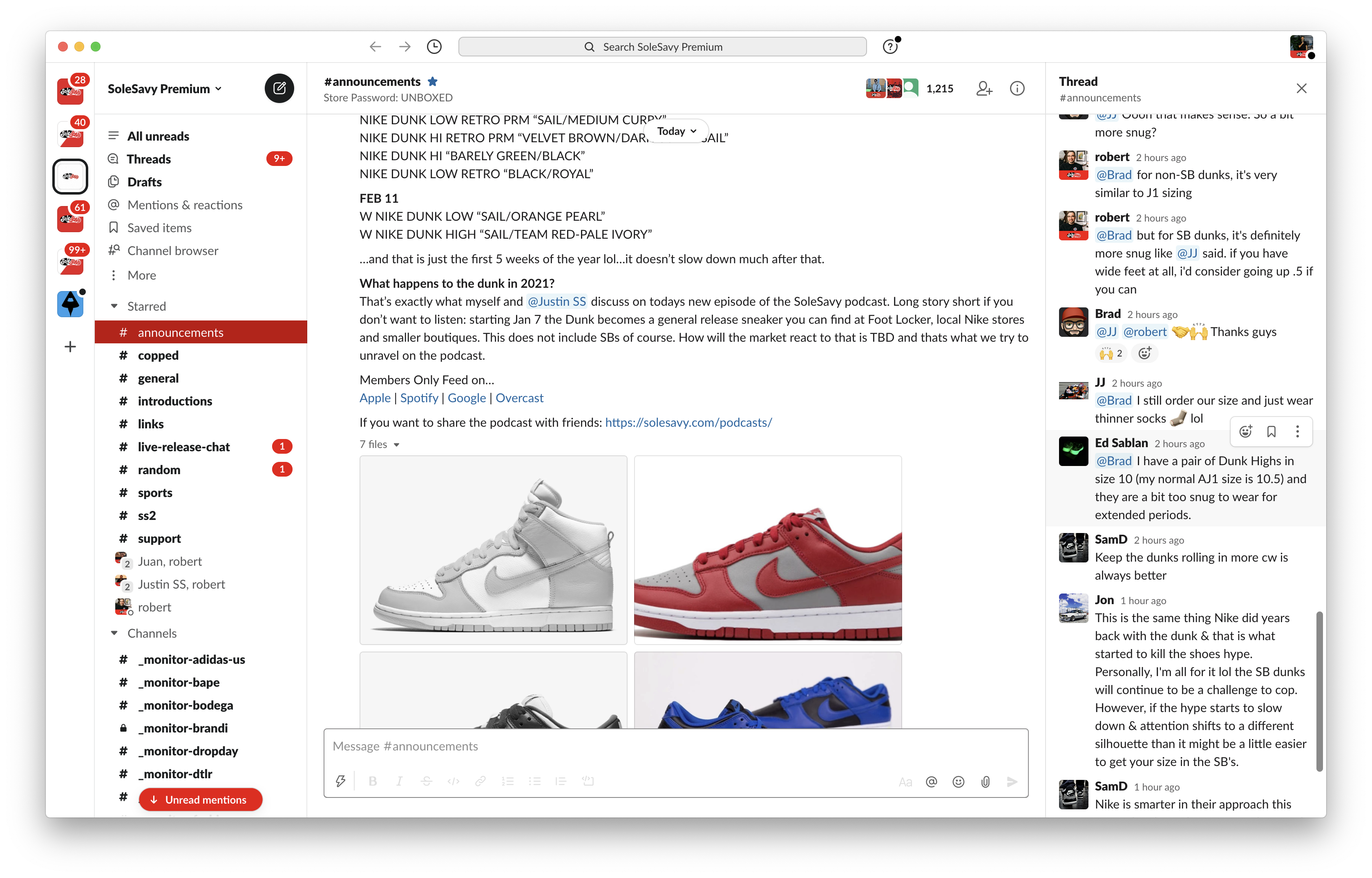- January 11, 2021
- by:
- in: Blog
SoleSavy, a community built around buying hot sneakers and related items that are increasingly hard to acquire at retail, raised $2M in a round that closed late last year. SoleSavy is a group of communities that is currently mostly hosted on Slack. SoleSavy’s co-founders Dejan Pralica and Justin Dusanj founded the company in 2018 as
SoleSavy, a community built around buying hot sneakers and related items that are increasingly hard to acquire at retail, raised $2M in a round that closed late last year. SoleSavy is a group of communities that is currently mostly hosted on Slack.
SoleSavy’s co-founders Dejan Pralica and Justin Dusanj founded the company in 2018 as a paid community for collectors and enthusiasts seeking pairs that were getting snapped up by bots or resellers. Pralica previously co-founded Kicks Deals, a sneaker shipping site focused on less than retail pricing and Dusanj is the former Director of Operations at New Age Sports, a Nike retailer.
SoleSavy’s $2M party raise includes investment from Panache Ventures, Jason Calacanis’ LAUNCH, Turner Novak, Ben Narasin, Morning Brew’s Alex Liberman and Austin Rief, Tiny Capital, Wesley Pentz (yes, Diplo), Matthew Hauri aka Yung Gravy, Ryan Holmes, Roham Gharegozlou and Bedrock Capital.
SoleSavy has built an engaged community (several communities, really) around the ebb and flow of the sneakerhead consumer universe (SCU). I just coined that, by the way, please make it a thing. The SCU is an interesting place filled with fascinating characters and behaviors. Every once in a while it pokes its head into the mainstream, whether via a documentary, a hot shoe release or a stron-garm robbery attempt. In 2021, I believe that we will see more of this world breaking out of its box into the larger consumer consciousness.
The trends that are leading us to this place are varied, but some of them have been front and center during the pandemic, as a decade’s worth of consumer behavioral change has occurred in the space of a few months. You only have to look at how hard it was to get a PS5 or Xbox One X or a GPU for the holiday season, and how many services, Twitter accounts and monitor groups rose up to try to help people do that to see what the future of shopping looks like.
I joked about not being able to buy butter without a bot, but it’s not far from the truth — nearly every category of goods has had its own shortages over the last year. But the mother of all limited goods category for decades now has been sneakers.
Every release is hotly anticipated and eagerly purchased by people looking for the latest shoe. The massive increase in interest in the sneaker as the marquee desirable item and the unwillingness of the biggest manufacturers to lose the hype halo has led to each drop being harder to get than the last. Second-market startups like StockX and GOAT have sprung up to facilitate those who don’t mind paying 30%-200% premiums on each release.
The solution for many lies in the countless ‘cook groups’ that help buyers anticipate demand and stock for each drop and plan to purchase them on release date.
SoleSavy’s function is ostensibly to do just that: help regular enthusiasts to strategize and execute the release day cop. But beyond that, Pralica says that the group has come to be about the community of people around those shoes more than the purchase itself.

SoleSavy is at its heart a slack group (a series of groups actually that act as cohorts, leading people through the tiers of community that the team has built) with rooms that help people to understand what’s happening in sneakers, get the releases and commiserate around the culture. Pralica says that they’ve built that community out slowly (the waitlist for the group grows by 400 people per day) in order to maintain a positive atmosphere and to properly onboard new people to the group. They also have an app that drives push notifications and a podcast.
That positive community vibe is what Pralica says is SoleSavy’s long-term focus and differentiating factor that keeps the 4,000 members across the US and Canada interacting with the group on a nearly daily basis.
I’ve been in a dozen or so different groups focused on buying large quantities of each release to re-sell over the years and many of them are, at best, rowdy and at worst toxic. That’s an environment that SoleSavy wanted to stay away from, says Pralica. Instead, SoleSavy tries to court those who want to buy and wear the shoes, trade them and yes, maybe even resell personal pairs eventually to obtain and wear another grail.
Though cook groups have been the ‘core’ of the Discord and Slack-based communities in the sneaker world, other iterations have been booming too. Entrepreneurial communities based in the same hustle principles like Tyler Blake’s In This Economy and fanbase-focused groups around popular streamers top the Disboard. And bets on social token outfits like Zora are also focused on community as the glue that holds together a user base.
Community is the future of all commerce, whether you’re looking for a specific product (see the huge PS5 monitors) or want to steep yourself in a particular universe of product interest (the SCU). The trends that I’ve been seeing all point to 2021 being the year that community-driven purchasing breaks out of the underbelly of fandom and becomes officially “a thing”.

SoleSavy has been experimenting with a variety of ways to keep the community knit going including live chats, get togethers and even a handsome custom community-designed Jordan 1. These efforts have driven the previously bootstrapped company to some impressive early numbers. Pralica says that SoleSavy is currently profitable, with $1.5M ARR on $33 monthly subscriptions plus affiliate revenue and that their DAUs are at 90% — an engagement number that would make any retailer salivate.
Though the funding closed (very) late last year I thought that this would be a great kick off story for the year ahead. Though SoleSavy seems to have a really compelling story and a great growth curve, I think they’re at the tip of a very large trend, one that we will see continue to build throughout the year.









